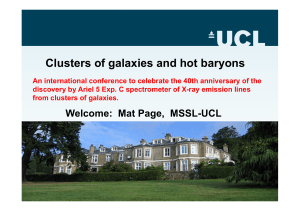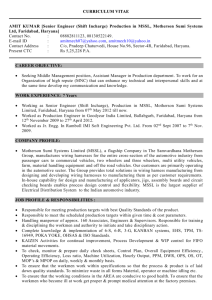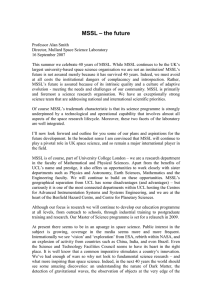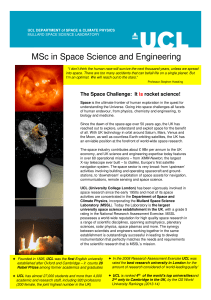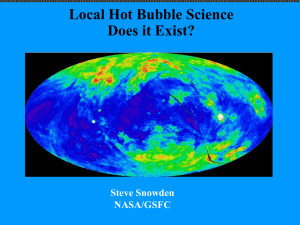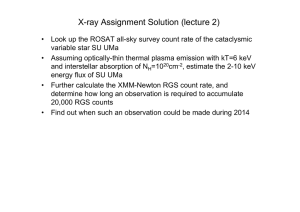Emission lines all around us: Charge eXchange near and far G. Branduardi-Raymont MSSL
advertisement
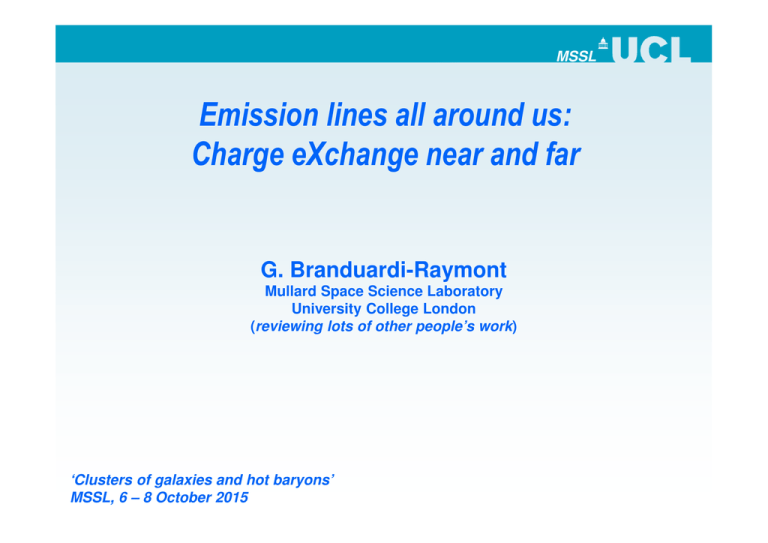
MSSL Emission lines all around us: Charge eXchange near and far G. Branduardi-Raymont Mullard Space Science Laboratory University College London (reviewing lots of other people’s work) ‘Clusters of galaxies and hot baryons’ MSSL, 6 – 8 October 2015 MSSL X-ray production by Charge eXchange (CX) • Charge eXchange (CX) Solar Wind Charge eXchange (SWCX) Highly ionised ions collide with neutrals/molecules electron capture (‘charge exchange’) de-excitation with X-ray line emission e.g. H2 + O7+ H2+ + O6+ + hν ν • Studied since origin of atomic physics • X-ray production efficiency recognised ~20 years ago: Jupiter & cometary emissions Cravens et al. 1995 & 1997, Dennerl 2010 (~10-15 cm2) • Very high CX cross-section so works well with low density target gas 7+ O O7+ 6+* O O6+* OO6+6+ Dennerl 2009 • Scattering of solar X-rays has cross-sections <10-18 cm2, so requires target of high density to be effective MSSL Comet C/2000 WM1, 2001 Dec. 13 – 14 Optical XMM-Newton Dennerl et al. 2003 MSSL Comet C/2000 WM1: combined RGS + EPIC pn spectrum residuals counts s 1 keV 1 EPIC pn RGS 1 RGS 2 0.2 0.3 0.5 instrumental energy [keV] 1.0 Dennerl et al., priv. comm. MSSL Jupiter – XMM-Newton, 2003: EPIC OVII (0.55–0.60 keV) MgXI (1.30–1.40 keV) FeXVII (0.70–0.75, 0.80–0.85) 5 – 10 keV B-R et al. 2007 MSSL Jupiter – XMM-Newton, 2003: EPIC Jupiter’s auroral and disk spectra C or S? OVII by CX North 0.2 – 2 keV: ~ 0.5 GW 2 – 7 keV: 90 – 40 MW Disk coronal spectrum South Electron bremsstrahlung B-R et al. 2007 MSSL Jupiter – XMM-Newton, 2003: RGS OVIII FeXVII OVII • RGS clearly resolves auroral CX from disk soft X-ray emission lines (but not the C/S ambiguity) • Width of OVII and OVIII lines corresponds to energies of few MeV for O ions MSSL Jupiter – Athena X-IFU simulation XMM-Newton RGS – 210 ks Athena X-IFU – 20 ks - Extended wavelength range - 2 orders of magnitude higher effective area - Non-dispersive spectroscopy MSSL Mars disk and exosphere (halo): XMM-Newton RGS • Fluorescent scattering of solar X-rays in CO2 atmosphere • Solar wind charge exchange (SWCX) in the exosphere +/- 50” +/- 10” - 50” to - 15” and + 15” to + 50” Dennerl et al. 2006 MSSL X-rays from Venus at solar maximum (2001) • Fluorescent scattering of solar X-rays in upper atmosphere • O-Kα, C-Kα (and N-Kα ?) detected; also CO/CO2 signature Chandra ACIS/LETGS Dennerl et al. 2002 • Venus exosphere more condensed than Mars SWCX radiation closer to limb Easier to detect at solar minimum (2006) Dennerl et al. 2012 SWCX Fluorescence MSSL X-rays from Venus at solar minimum (2006) Chandra ACIS • First evidence of exosphere X-rays from SWCX at the sunward limb 0.29 – 0.51 keV • O-Kα fluorescence of solar X-rays uniformly distributed over illuminated disk 0.51 – 0.55 keV C, N O-Kα α 0.55 – 0.79 keV • Spectra from the two regions are indeed different Dennerl et al. 2008 OVII MSSL The Earth’s geocorona • LTE of the ROSAT All Sky Survey ¼ keV background Snowden et al. 1995 • Time variable O emission lines on the dark side of the Moon Chandra ACIS Wargelin et al. 2004 Correlation with solar wind flux SWCX in Earth’s geocorona • Suzaku observations of the NEP: Increase in soft X-ray lines correlated with solar wind proton flux • Systematic study with XMM-Newton Carter et al. 2008, 2010 (CME), 2011 Fujimoto et al. 2007 MSSL A global view of the Earth’s magnetosphere • SWCX expected to produce a large increase in X-ray line flux during solar wind storms • SWCX X-rays can be used to image boundaries of the Earth’s dayside magnetosphere • Validate models and reach better understanding of the Earth’s response to the impact of the variable solar wind • SMILE joint ESA and CAS mission currently under study: soft X-ray telescope, highly elliptical polar orbit B-R, Wang et al. 2015 MSSL The Earth’s magnetosphere on 17th March 2015 T. Sun, 2015 MSSL Solar system CX X-ray emission as a ‘background’ • The heliosphere is also shining in SWCX X-rays by SW encounter Cox 1998 with inflowing ISM stream • Solar system CX (geocorona and heliosphere) now treated as b/g: can be separated by variability, e.g. XMM-Newton HDFN, Chandra MBM12 molecular cloud, Suzaku NEP observations Snowden et al. 2004, Smith et al. 2005, Fujimoto et al. 2007, Carter et al. 2011 • Controversial claim of detection of WHIM emission, with possible SWCX OVII possibility Kaastra et al. 2003, Bregman Lloyd-Davies 2006, Nevalainen et al. 2007 • Local Hot Bubble affected by solar system CX (~60 pc cavity around Sun, 106 K emission, now to be shared with geocoronal and heliosphere CX): a large part, if not all, could be due to CX Koutroumpa et al. 2007, 2008, 2009 • Can be resolved via line ratios with high resolution spectrometers MSSL High resolution spectroscopy of CX X-ray emission • CX X-ray emissions have no continuum, only lines and different line ratios from cooling hot gas • Cross-sections for collisional (hot) plasmas strongly favour n= 2 1 >> 3 1 >> 4 1 etc. … • Not so for CX: High-n lines enhanced at low collision energies, more for H-like than for He-like spectra • For Heand H-like Wargelin et al. 2008 spectra … MSSL Hot gas – cool clouds interfaces • Interfaces between hot gas and cool clouds in ISM expected to be likely locations of CX emissions • For H atom in a hot plasma mean free path for CX ~ same as mean free path for collisional ionization Lallement 2004 MSSL Extra-solar CX X-ray emission scenarios Expectation/evidence for CX in • • • • • • • Local ISM: North Polar Spur SNRs High velocity clouds in Galactic halo Galactic Ridge Stellar winds Galactic winds Clusters of galaxies MSSL Local ISM: North Polar Spur Emission in unresolved OVII and NeIX triplets shifted to lower energies by 10 – 15 eV w.r.t. OVIII and NeX Lallement 2009 Miller et al. 2008 Willingale et al. 2003 MSSL Supernova Remnants • SNR also contain interfaces between hot gas and cool clouds • Early CX suggestions Chamberlain 1956, Serlemitsos et al. 1973 • Detailed study of expected CX emission in SNR from neutral H and highly ionised heavy ions at periphery of fast shocks vs collisional ionisation, recombination, excitation CX no more than 10% (unless gas mixed) Wise & Sarazin 1989 • While CX emission from interface regions is negligible, it could be enhanced by limb brightening Lallement 2004 • Cygnus Loop: Suzaku spectra, OVII triplet enhanced forbidden to resonance line throughout the rim; correlation with Hα filaments Roberts & Wang 2015 • Need to model CX contribution! MSSL The Galactic halo • Galactic halo itself may have significant CX: MHD simulation of SN-driven ISM (hot gas flow from disk to halo) under-predicts 0.5 – 2 keV surface brightness Henley et al. 2015 High velocity clouds in Galactic halo • ROSAT flux from high velocity clouds is ~ same order expected for CX from clouds in a hot halo Kerp et al. 1999, Lallement 2004 MSSL Galactic Ridge • CX has been considered as possible origin of X-ray emission from Galactic Ridge (disk-like region around GC, radius several kpc, scale height ~ 100 pc) • Early investigations Watson 1975, Blint et al. 1976, Christensen et al. 1977 • CX by low energy CR heavy ions with ISM neutral H (ASCA) Tanaka et al. 1999, 2002 • Not supported by Suzaku observations (higher resolution, OVII …) Ebisawa et al. 2008 • However, more recent Chandra observations do not support CX hypothesis, rather superposition of individual sources Revnivtsev et al. 2009 MSSL Stellar winds: late-type stars • SWCX with ISM neutrals entering the heliosphere winds in late-type stars Wargelin & Drake 2001 • Stringent constraints on mass loss from Proxima Centauri from absence of CX emission Wargelin & Drake 2002 • Exoplanets: Stellar wind – Hot Jupiter CX can produce 1022 erg s-1 X-ray emission (106 x Jupiter aurora) Kislyakova et al. 2015 MSSL Stellar winds: The Orion Nebula • XMM-Newton EPIC spectra show that hot plasma at ~ 2 MK pervades the SW extension of the Nebula and must be flowing into the adjacent ISM Guedel et al. 2008 • Hot gas channelled by cooler structures • Outflow phenomenon (and CX) may be common to massive star-forming regions likely CX production MSSL Galactic winds: M82 & M31 • Starburst galaxy winds have been shown to interact with cool halo clouds CX X-ray emission could be non-negligible Lallement 2004 • Hot wind drives a shock wave into cool clouds and heats them, clouds recombine and emit Hα, X-rays from shocked wind + CX • Possible detection of a CVI transition (n = 4) at 0.46 keV in M82 Tsuru et al. 2007 • M82 OVII triplet line ratios consistent with those expected for CX Ranalli et al. 2008 • Similar OVII line ratio implications for M31 Liu et al. 2010 ratio MSSL Galactic winds: M82 & M51 • Detailed analysis of 104 ks XMM-Newton observation of M82 Zhang et al. 2014 with CX & thermal plasma model • CX largely responsible for enhanced forbidden lines of various He-like ion triplets and good fractions of Lyα transitions of CVI, OVIII and NVII • M51: Thermal spectrum but OVII triplet is forbidden line dominated • OVII triplet flux located at faint regions near edges CX? Liu & Mao 2015 Power law – black Thermal plasma – orange CX – purple MSSL Clusters of galaxies • X-ray emission from central regions of clusters so bright to imply cooling of intracluster gas on timescales shorter than cluster’s lifetime • Spectra (e.g. XMM-Newton RGS) of cooling gas cannot be fitted by cooling flow models: expected coolest gas is missing Peterson et al. 2003 • Optical (Hα) filaments correlated with X-ray emission suggest interfaces formed in mixing layers CX at interfaces producing X-rays • Estimates suggest that CX contribution non negligible, could mimic emission from hot gas and lead to overestimate the cooling if pure cooling flow model applied Lallement 2004 MSSL In summary: CX is really ubiquitous in the Universe, so we are better to get used to including it in our spectral modelling! Thank you
